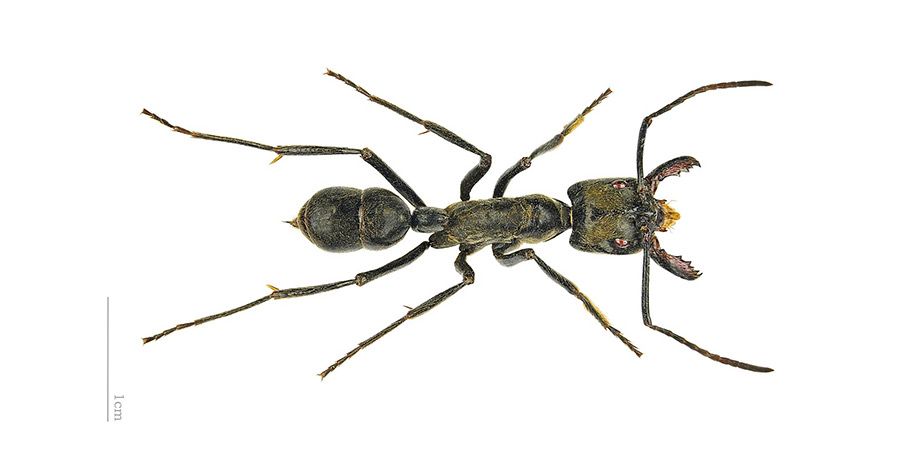Sue Perkins introduces A Housefly Buzzes In The Key Of F book

New book A Housefly Buzzes In The Key Of F, written by Simon Nicholls, comes out of Radio 4 comedy show Nature Table. It delivers fascinating facts on all things flora and fauna in an amusing away.
Here's the foreword Nature Table host Sue Perkins has written for the book, followed by an extract in which we learn more about South American Giant Ants.
Foreword by Sue Perkins

My childhood experiences with nature were somewhat limited. I grew up in Croydon in the 1970s, where 'green spaces' were the cracks in the pavement where the weeds poked through. My interactions with the animal kingdom were similarly restricted. The sum total of our household pets amounted to two gerbils - both of whom bred and ate with admirable ferocity. They departed this Earth after a mere three years, fat and exhausted, and were not replaced. Other than a brief holiday spent fostering our neighbour's dozy Samoyed dog and a hamster with elephantiasis of the testicles, that was it.
However small my window into the natural world might have been, I was nonetheless transfixed. Wandering through the small boulevard of stooping trees that boldly proclaimed itself as the local wood, I'd feel a sense of calm not normally afforded me by my skittish brain circuitry. I'd be delighted by the industrious thrum coming from the lavender when the bees arrived each year. I remember being six years old, gently unwinding a red admiral caught in the sticky skeins of a spider's web, and the pure delight as I set it free. And my dog. Don't get me started on my dog. My eyes still prick at the memory of her cashmere-soft fur as she settled down for her very first night's sleep next to me.
It's no surprise then, that hosting BBC Radio 4's Nature Table is a complete joy. My role is a simple one. I relax back in my chair and am transported by our experts; taken across continents, through time and space, across sea, land and sky as they bring me wild and curious stories of this planet's riches. I've learned about gay albatrosses, parasitic wasps, and heard a truly incredible, albeit harrowing, tale of a drug-addled cicada whose bottom half was eaten away by an invasive fungus - but hey, he's too high to notice...
In between the laughter - and there is much laughter - there is awe. A reverence at the adaptability, complexity and ingenuity of species. Oftentimes, I find myself lost for words (a rarity, ask anyone), open-mouthed at the behaviours, tropes and, frankly, mating rituals of our plant and animal cohabitants. Often the things I learn are more astounding than anything you could dream up during even the most fecund of cheese-dreams.
This book is a celebration of these idiosyncrasies; a love story to all the diverse, bizarre, beautiful, shocking living things with which we share our planet. When you feel tired or that life has become humdrum, look no further than these pages to remind yourself of the magic all around us.
Now, more than ever, we should cherish our environment. All we need is a curious mind. From that comes everything that defines the very best of humanity - understanding and empathy. Right now, our planet needs us to have both: understanding and empathy. Let's stop destroying the very thing that sustains us. Let's love, honour and protect this precious, precious world.
South American Giant Ants

The South American giant ant is - spoiler alert - a giant ant found in South America. Its habitat tends to be the rainforests of the Andes in Peru, Ecuador and Colombia. But these ants also live in the savannah and lowland rainforests of Brazil, Guyana, Bolivia, Paraguay and Argentina. Giant ants can reach a whopping - drum roll please - 3-4cm long. That may not immediately say 'giant' to you but let me tell you, in ant terms South American giant ants ARE HUGE! They're among the largest ants in the world.
Female South American giant ants are serious wonder women
I'm not exaggerating when I say South American giant ants are badass. As the very marvellous Dr Claire Asher explained when she joined us on the show, South American giant ants have a mesmerising, female-led social structure...
One ant does not a colony make
You're probably aware that ants live in colonies, with a queen at the top of the hierarchy. Usually, the queen ant is the only female ant allowed to reproduce. However, South American giant ants are different. One might say they're more progressive...
Every giant female ant in the colony can reproduce. But to stop it being a free-for-all chaotic ant orgy in the nest (never thought I'd put those words together in a sentence), the females are organised and relatively polite to one another. The female ants maintain and respect the hierarchy, as they queue to decide who reproduces next!
Did somebody order a knuckle sandwich?

If I'm honest, saying that giant female ants queue 'relatively politely' for sex is stretching it. Fights among females often break out, as they squabble over their place in the queue. Research has shown that female giant ant fights often involve hitting each other in the crotch (not dissimilar to an EastEnders Christmas special, but with more ants).
To establish supremacy over one another, females also box each other around the head with their antennae. And if that's not enough to jump the queue, they do a thing called 'gaster rubbing'. This is where one female curls her abdomen round and rubs it on the antennae of another female - effectively playing a rudimentary game of Sniff My Crotch! Charmed, I'm sure.
Where are the male giant ants in all this?
The truth is, male giant ants don't live very long. Colonies produce males, the males mate with the females and then the males die. The process of mating actually kills the male, meaning the males are little more than walking sperm. Wham! Bam! Goodnight!
Giant ant mums do a thing called 'whatever I want'
Dr Claire Asher went on to explain that once a female giant ant has mated, her focus is on egg laying. Then, as soon as the offspring are born, they immediately become her worker ants! From that moment on, the adult female does nothing other than lay more eggs, whilst her kids do all the menial chores around the nest. Tasks like cleaning the oven, defrosting the freezer, defending the nest against predators and ironing mum's socks - that sort of thing. From the mother giant ant's perspective, the logic is: 'I've brought you into the world, now look after me!' I think I remember my grandmother saying something similar to my mother.
So, that's wonder women South American giant ants. Before we move on, how about we play a quick game of everybody's favourite quiz, Ant or Not?
Did you know that there are an estimated 22,000 species of ant? That's a lot of names to come up with. Many have been named after celebrities. For example, there's an ant called Pheidole roosevelti, named after US President Teddy Roosevelt.
Ant or Not
Ant or Not is a very simple game. I'll give you the scientific name for an ant, and you have to decide if it's a real ant or a not real ant. Let's play...
Is this a real ant, named after a famous person: the Pheidole harrisonfordi?
Answer: It's real. There is a Harrison Ford ant. You can see it starring in Indiana Jones and the Picnic of Doom.
What about the Sericomyrmex radioheadi? Ant or Not?
That's also a real ant. It gets a bit angry if you keep asking it to play the song Creep.
How about the Pheidole freudi? After Sigmund Freud? Ant or Not?
It's not an ant. There actually isn't an ant named after Sigmund Freud. But his name has been given to a penis. I mean beetle.
What about the Doronomyrmex Pocahontas (try saying that with a Fruit Pastille in your mouth)? Ant or Not?
It's an ant! There is indeed an ant named after Pocahontas. A much better tribute to her than that film where she ended up with Mel Gibson.
And finally - what about the Sericomyrmex sueperkinsi? Ant or No
Sadly, there's no organism yet named after national treasure Sue Perkins. But if anyone reading this is working in an animal naming department, then we think Sue would suit a majestic leopard... though, to be honest, she's also told us she'd be happy with some sort of woodlouse.
Help us publish more great content by becoming a BCG Supporter. You'll be backing our mission to champion, celebrate and promote British comedy in all its forms: past, present and future.
We understand times are tough, but if you believe in the power of laughter we'd be honoured to have you join us. Advertising doesn't cover our costs, so every single donation matters and is put to good use. Thank you.
Love comedy? Find out moreA Housefly Buzzes In The Key Of F

Fascinating Facts on All Things Flora and Fauna.
Did You Know That...
A housefly buzzes in the key of F?
A cockroach can live for a week without its head, before dying of starvation?
Slugs have four noses? So, if you thought that couldn't get slimier, now imagine them with a cold.
The fingerprints of a koala are so indistinguishable from humans that they've been confused at a crime scene?
During its lifetime, a cow can produce nearly 200,000 glasses of milk? Which is extraordinary, because where is it getting all those glasses?
The natural world is an amazing, compelling and funny place: a place where fact is always more staggering - and often funnier - than fiction. Based on BBC Radio 4's hit science and comedy series Nature Table, and with a foreword from the show's presenter, Sue Perkins, A Housefly Buzzes In The Key Of F is a celebration of the astonishing everyday occurrences that happen right under our noses. With fascinating facts from the programme's expert guests along with big jokes, witty anecdotes and fun games, this bumper collection showcases our planet's flora and fauna in all its remarkable and surprising glory.
First published: Thursday 9th November 2023
- Publisher: Blink Publishing
- Pages: 240
- Catalogue: 9781788709194
![]() Buy and sell old and new items
Buy and sell old and new items
Search for this product on eBay
BCG may earn commission on sales generated through the links above.
- Publisher: Blink Publishing
BCG may earn commission on sales generated through the links above.
- Publisher: Blink Publishing
![]() Buy and sell old and new items
Buy and sell old and new items
Search for this product on eBay
BCG may earn commission on sales generated through the links above.

